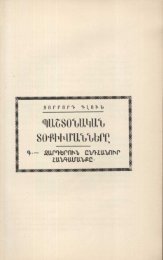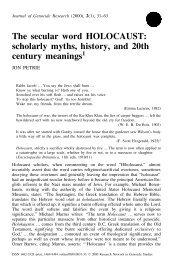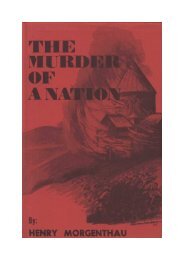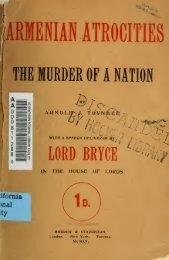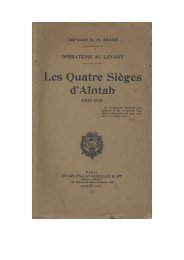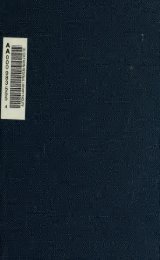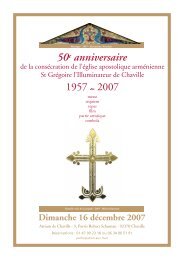2.1.5 1919In 1919, the Swedish Missionary, E. John Larson, with experiences fr<strong>om</strong> his work in Turkey andthe Middle East, published a book, Vid Ararats fot (“At Ararat’s foot”), writing about the SwedishMission’s 35 years activity in Caucasus. Describing the situation in Caucasus, Larson mentionsthe 1894-96 “Bloodbath in Armenia,” how the Turkish Armenia is now emptied of Armenians,and the numerous immigrants seeking shelter in Caucasus. 2451919 was the year in which the Turkish Government desperately tried to salvage as much as itcould. Under Entente pressure the Turkish Government issued orders for arresting allgovernmental and military members who were suspected of having c<strong>om</strong>mitted crimes againsthumanity. Most of the leading figures, including Talaat, Enver, Djemal and Dr. Shakir fled toGermany before they were arrested. 246 Many others escaped captivity. Nevertheless, a largenumber of them were put on trial and convicted. 247On January 3, SvM published a note, asserting that “According to a French investigation, themassacres in Armenia have claimed 1.5 million victims.” 248 On February 11, SvM publishedanother article mentioning the trial of the “executioners of Armenians.” The article noted that“Governors and c<strong>om</strong>manders, who are accused of instigating the massacres, are being tried incourt martial trials.” 249In an article, published in SvM on February 25, the w<strong>om</strong>en of Scandinavia appealed for thesake of the Armenians. An ad in the same paper rec<strong>om</strong>mended the two books, Blod och tårar andVid Ararats fot. 250On August 15, SvM informed of an American investigation c<strong>om</strong>mittee, an initiative by the USPresident Wilson, sent to Armenia to exa<strong>min</strong>e the situation fr<strong>om</strong> a military perspective. 251 OnSeptember 1, DN published the news about the discussion of US mandate over Armenia, adecision condemned by the Republicans. 252 In his report dated February 24, 1919, Wirsén looksforward to co<strong>min</strong>g h<strong>om</strong>e and gives a general description of the situation in the country, warningStockholm about the imposing migration wave, “a catastrophe in the entire Europe, worse thanany other since the great migrations during the Middle Ages.” The following remark is, however,interesting:The general situation in the Orient is unclear in so far as the fact that no definitive decisions aremade in regard to Turkey’s position. That this old rotten butcher-state can not be allowed to existas it has up till now, is, however, clear and must be agreed upon. 253245 Larson, 1919, p. 66-69, 99.246 Dadrian, 2004, p. 319.247 Dadrian, 2004, p. 321-333.248 SvM, January 3, 1919.249 SvM, February 11, 1919.250 SvM, February 25, 1919.251 SvM, August 15, 1919.252 DN, September 1, 1919.253 KA, Generalstaben, letter 1, February 24, 1919.56
Here Wirsén took the liberty to c<strong>om</strong>ment on the nature of the Ott<strong>om</strong>an Empire, revealing histhoughts about the internal structure of the Empire as well as the maltreatment of the subjects.In a report to the Swedish Defence Minister, dated October 10, 1919, Wirsén described thenew Kemalist movement, how it has helped the jailed Turkish military awaiting court martial toescape, their advancing towards Constantinople and how the new regime is highly influenced byformer members of the Union and Progress Party:Another proof of the Union Party’s influence is that one of the leading figures of the party,Doctor Nasim, regarded as one of the instigators of 1915 Armenian massacres, is said to be backin Anatolia and is again playing an [active] role there.It is characteristic that, at the same time, we have received quite firm rumours about newmassacres of Christians, especially in Eastern Anatolia and in the western parts of the formerRussian Caucasus, i.e. in Armenia. 254Thus, it was known that the massacres were still ongoing, in spite of the signing of the ceasefiretreaty, still ongoing, now under the leadership of the new Kemalist movement, the founders ofthe future Turkey.1919 marked the beginning of the turning point for the Armenian question. The ceasefire hadput an end to the large scale massacres and deportations and numerous Turkish leaders werearrested, charged with having c<strong>om</strong>mitted war crimes. The massacres had not ceased c<strong>om</strong>pletelyand Sweden watched the events closely and followed the development on the international levelregarding a possible c<strong>om</strong>pensation for the sufferings of the Armenian nation.The period of 1915-1919 (and to s<strong>om</strong>e extent also a portion of 1920), was a time ofobservation and condemnation of the actions c<strong>om</strong>mitted against the Christian <strong>min</strong>ority inOtt<strong>om</strong>an Turkey in general and the Armenians in particular. But up till this m<strong>om</strong>ent, thecondemnations came fr<strong>om</strong> the enemy camp, unaffected by incentives which Turkey could offeras payment for looking in the other direction. As far as Sweden was concerned, the dispatchedreports contained a clear picture of the actual events taking place in Turkey, but the SwedishGovernment neither protested nor initiated any international actions. Its policy of strict neutralitydictated Sweden’s isolationism and passively following the unfolding of the world events.2.2 1920-1923: Time of Political Abandonment, Denial and Dissociation2.2.1 1920The discussion of the Armenian question reached its peak during 1920 and a solution seemed tobe at hand. The Sèvres Treaty, signed on August 10, 1920, established the creation of anindependent Armenia and assigned the arbitrary responsibility of designating the borders betweenthe new republic and Turkey to the US President, Woodrow Wilson. 255 But soon, it was prooved254 KA, Generalstaben, letter 20, October 10, 1919.255 World War I Document Archive, 2007.57
- Page 3 and 4:
1 Introduction.....................
- Page 5 and 6: War, rather confirm the version of
- Page 7 and 8: 1.2 Previous ResearchWhen discussin
- Page 9 and 10: Military Attaché and the missionar
- Page 11 and 12: situation: “It is a crime when Te
- Page 13 and 14: in the following investigation, whi
- Page 15 and 16: killed. The slaughterer slaughtered
- Page 17 and 18: interests. Despite his famous “14
- Page 19 and 20: morality, balance of power, or the
- Page 21 and 22: 4. International organisations (e.g
- Page 23 and 24: warring parties. 104 This observati
- Page 25 and 26: Concerning the protocols of the Swe
- Page 27 and 28: present in Turkey. These documents
- Page 29 and 30: He also mentions meeting an Armenia
- Page 31 and 32: the annihilation. General von Losso
- Page 33 and 34: 1.5 BackgroundIn order to understan
- Page 35 and 36: 1914, when two inspector-generals f
- Page 37 and 38: to Islam or were sold as slaves to
- Page 39 and 40: 2 Empirical AnalysisThe empirical r
- Page 41 and 42: It does not seem to be the Turkish
- Page 43 and 44: The Turks claim that, at the Russia
- Page 45 and 46: The Armenian population has equippe
- Page 47 and 48: 1917 was the revival year for the A
- Page 49 and 50: Even if the communication between t
- Page 51 and 52: implemented against the Armenian na
- Page 53 and 54: Anckarsvärd continued claiming tha
- Page 55: Germany is blamed for its accessory
- Page 59 and 60: On February 19, news of new Armenia
- Page 61 and 62: estricted to the fields of intrigue
- Page 63 and 64: generous offer of President Wilson
- Page 65 and 66: Lange gave a detailed description o
- Page 67 and 68: skin was totally scorched. Another
- Page 69 and 70: which her recurrently emphasised th
- Page 71 and 72: The sooner calls referring to the A
- Page 73 and 74: Despite these facts, Armenia was th
- Page 75 and 76: Svenska Riksarkivet [Swedish Nation
- Page 77 and 78: Bakhtiari, Kalla det vad fan du vil
- Page 79 and 80: Chan, Steve and Drury, Cooper A., S
- Page 81 and 82: Moranian, Suzanne Elizabeth, Bearin




